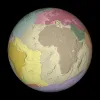Take a look inside 5 images
Puzzling Plates
Pros: Interactive activities help kids visualize and learn about plate tectonics; bonus activities assess learning.
Cons: There aren't any practice activities, so kids will need some prior knowledge of the concepts or they might get frustrated when they lose points right away.
Bottom Line: This great Earth science tool gives kids an opportunity to interactively explore concepts related to plate tectonics.
It could be fun to use Puzzling Plates as a follow-up challenge during a unit about plate tectonics. The levels are nicely arranged into specific topics, which makes it easy to have kids work on a level that aligns to a particular lesson. Start by assigning students to a partner and creating a class leaderboard. After teaching about the plate locations, have kids work on Level 1 with their partners, and then rank teams based on their scores using the class leaderboard. After teaching about Earth's layers and the relationship between plate boundaries, earthquakes, and volcanoes, kids work on Level 2 with their partners, again ranking teams on the leaderboard. Finally, after teaching about the types of plate boundaries, have kids work on level 3, and then determine the leading team. If time allows, try the free teacher activities offered on the developer's website after kids finish each level. Note that clicking on the link for the activities will take you to a different website, but the site is meant to provide learning support for teachers.
Puzzling Plates is an interactive Earth science tool that teaches kids about plate tectonics with three categories, or levels, of activities. In the first level, kids drag, drop, and rotate puzzle pieces into place to show how Earth's tectonic plates fit together. Kids earn points for getting the puzzle pieces in the correct places, but they lose points if they use a help feature that shows the completed puzzle. Kids drag labels to corresponding plates in the bonus activity. In the second level, kids earn points by investigating the relationship between earthquakes, volcanoes, and plate boundaries. They drag a target symbol over a world map to identify locations of earthquakes and volcanoes. Kids drag labels to identify the layers of Earth in the bonus activity. In the third level, kids watch animations that show three main types of plate boundaries: convergent, divergent, and transform. Then, they identify boundary types on a world map by dragging the correct buttons to match each boundary on the map. Kids earn points for getting the boundary correct on the first try. In the bonus activity, kids are given an up-close view of a boundary and must use their fingers to indicate the correct motion of the plates.
With interactive levels that challenge, score, and assess learning, Puzzling Plates is a valuable science tool for the classroom. The levels have activities and bonus rounds that cover specific topics related to plate tectonics. Kids will learn about the locations and names of tectonic plates; the relationship between plate boundaries, earthquakes, and volcanoes; and the three main type of plate boundaries. Kids can get help and explanations when needed, but in some cases the help will cost points. Some practice opportunities would be a beneficial feature of the app, especially for kids who are just learning the material.













